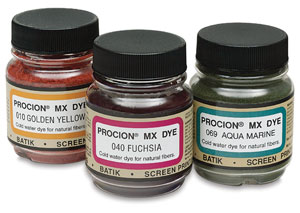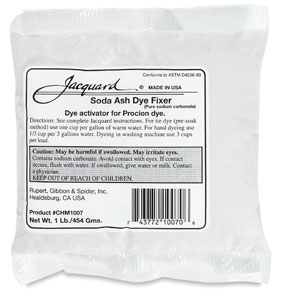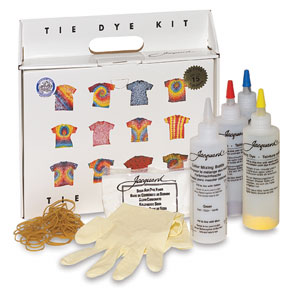Is it possible to presoak the T-shirts in the Soda Ash, wring it out and let the shirts dry, before tie dyeing later?
Name: Sue

Procion dyes are permanent, colorfast, and very washable. You can easily create a palette of brilliant colors ranging from light pastels to deep, vibrant hues. Perfect for natural plant fibers - cotton, linen, paper, reeds, and wood.
Buy from Blick

Jacquard Soda Ash
Soda ash, or sodium carbonate, is the dye fixer used with Procion MX dyes. Procion dyes with soda ash create a strong permanent chemical bond with the cotton, so they simply do not wash out. Soda ash will not work with all-purpose dye such as Rit.
Buy from Blick
and help support this web site
Jacquard Tie Dye Kit

Dye up to 15 adult-size T-shirts, with vivid, electric colors that are so colorfast they can be washed with the daily laundry. Procion MX Fiber Reactive Dyes are already pre-measured for you in squeeze bottles. Just add water. Use on non-synthetic fabric.
Buy from Blick
and help support this web site
Country or region: Minnesota
Message: I teach a group of students with behavioral issues, which means, for art, what they say they will do one day, they won't the next, then decide they'll do it two days later. Several have had great interest and success in tie dyeing. Is it possible to presoak the T-shirts in the Soda Ash, wring it out and let the shirts dry, then dampen them before tie dyeing at a later time? Or does it lose its chemical properties. I have prepared Soda Ash for 7-8 shirts and then only 3 students will participate, only to have others decide they'd like to do this a few days later. This is the nature of their approach to anything - either want it done yesterday or have to warm up to an idea. Although Soda Ash is not expensive I do have a limited budget. I appreciate your input as my internet search did not zero in on this question.
There's no problem with saving 100% cotton shirts that have been treated with soda ash. In fact, many tie-dye artists prefer to soak their fabric or clothing in soda ash, then line-dry them so that the soda ash remains in the fabric, ready to react with the dye. Because of the reduced amount of liquid present when the dyes are applied, the effects can turn out to be a little more intense. You don't have to re-dampen the shirts before applying dye, because the dye mixture itself has plenty of water in it; if you do dampen the shirts, you'll probably want to just mist the shirts lightly with a spray bottle. It can be a little harder to get the dye to absorb into the dry soda-soaked cotton instead of rolling off, so it may be necessary to apply the dye a more slowly, but this is made up for, for the dyers who prefer it, by extra-intense colors. (Never use machine-drying for preparing dry soda-soaked shirts, because the high pH of the soda ash makes the soda-soaked cotton more inclined to catch fire in a hot dryer; there's no problem with the dryer, by the way, once the soda ash has been rinsed out.)
The problem is that handling the dry soda-soaked shirts can cause irritation to the hands, if gloves are not worn, and some people are sensitive enough to the irritating high pH of the soda ash that they can develop a respiratory irritation if they spend too much time working with the soda-soaked fabric. Make sure that anyone who is tying pre-soda-treated fabric wears gloves, and possibly a dust mask, as well. Be alert for coughing as a sign of irritation from the soda ash.
I do not like to have children tie soda-soaked fabric (I don't like to do it myself, because the fingers of the gloves always get caught in the string or rubber bands), so I prefer for them to tie their shirts before soaking. They can tie clean dry shirts, or, if they want a little more control, they can tie shirts that are dampened with plain water. After the shirts have been tied, they can be dropped into the bucket of soda ash solution to soak, even if they are damp to start out with. It's unlikely to do any harm to 100% cotton shirts for you to just leave the shirts in the bucket for days, if the person who puts them in gets distracted. You can also remove the soaked shirts, gently squeezing out extra soda ash solution with gloved hands, then set them aside in plastic bags. While ordinary damp laundry that is left wet for several days will get moldy, the soda ash should prevent anything like mold from growing, even if you leave it for a week or more. Some dyers tie their shirts, then soak in soda ash, then leave the shirts out in the air to dry for many days before applying dye to them. As is obvious, a tied soaked shirt will take much longer to dry than a soda-soaked shirt that is hung out on a line.
It's worth noting that the soda ash in the bucket will never go bad. One cup of soda ash in a gallon of water is not going to let anything grow in it, and soda ash does not tend to break down chemically into anything else. (In fact, baking soda will break down eventually to form soda ash.) You can save and reuse soda ash solutions indefinitely, until they are all used up. Let me warn you, however, about your choice of storage container. A bucket will be fine, as long as it doesn't get tipped over and nothing falls into it (including rain). Do not store the soda ash solution in plastic milk jugs! Plastic milk jugs are exceptionally flimsy, and are apt to get holes in them after a time, so that the soda ash solution leaks out. This is an inconvenience you do not need. If you have some empty jugs that once held vinegar, those are much thicker and will work fine indefinitely. Just make sure, whatever container you use, that its walls are thicker and stiffer than a gallon milk jug. There is no need to refrigerate saved soda ash solution.
If you are saving pre-tied shirts for some time, or if several people are dyeing at once, you will want a good way to label the shirts so that you know which one belongs to which person. Tyvek envelopes can be cut up to make tags that you tie onto the shirts. Obviously, though, pen marks may dissolve during the soda ash soaking, especially if it turns out to be extended for several days. I recommend using a hole punch or scissors to make codes on the Tyvek tags, keeping a record of what code each person uses. Don't use metal pins that may rust to attach them.
The tie-dye dyes will go bad after a while, once they have been mixed with water. If even one drop of soda ash gets into a bottle of dye mixture (as can happen when the nozzle is inserted deep within a fold, or if someone uses a paintbrush to repeatedly apply dye mixture to soda-treated fabric), the dye will go bad within hours. If no soda ash gets into the dissolved dye, then it will last for a couple of weeks or even longer, gradually getting weaker with time, although the dye mixture appears just as dark in the bottle even after it's gotten weak. If your students do dye painting on soda-soaked and dried shirts, you will want to pour out just enough dye for each one to use in an hour or less, saving the rest of the dye mixture you have dissolved so that it will still be good later in the week. The dye mixtures will stay good several times longer if they are refrigerated, even up to two or three months if 100% repeatable colors are not a priority, but there must be some way to make certain that no one will confuse dye mixtures in the refrigerator with drinks, such as a refrigerator that is not used at all for food, or a cardboard box that is taped shut with the bottles inside it. The dyes are not very toxic and won't kill someone who drinks them, but obviously they are not safe to drink, all the same; many dyes and colorings that have not been tested for safety in food could possibly increase the risk of cancer in someone who consumes them.
I hope this information will save you some trouble and maybe even a little supply money in working with your students.
(Please help support this web site. Thank you.)
(Please help support this web site. Thank you.)
Posted: Monday - March 25, 2013 at 07:49 AM
Follow this blog on twitter here.
Quick Links
- All About Dyes & Dyeing Top -
- Top of this blog -
- FAQ -
- The Dye Forum -
- How to Tie Dye - How to Batik -
- Books - Toys - Plants -
- Top of this blog -
- FAQ -
- The Dye Forum -
- How to Tie Dye - How to Batik -
- Books - Toys - Plants -
More in this category:
- -
Statistics
Total entries in this blog:
Total entries in this category:
Published On: Apr 16, 2013 08:01 AM
Total entries in this category:
Published On: Apr 16, 2013 08:01 AM